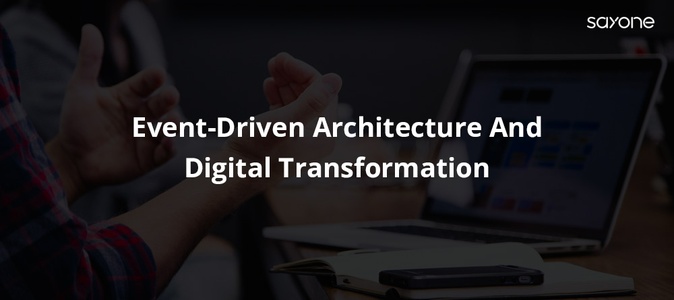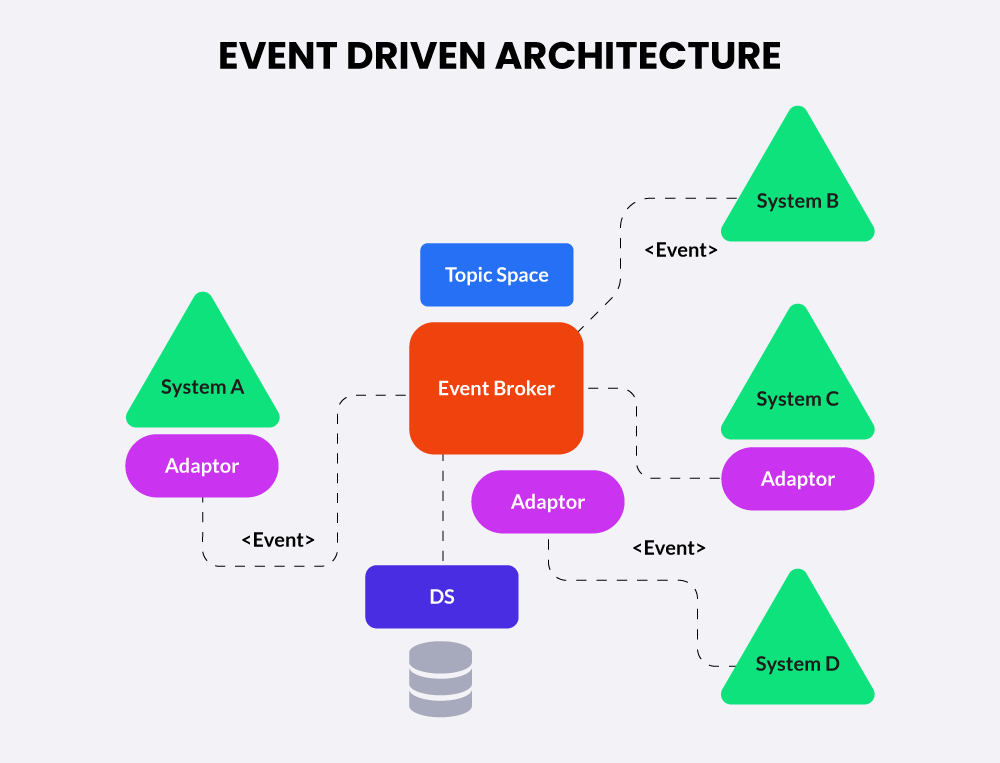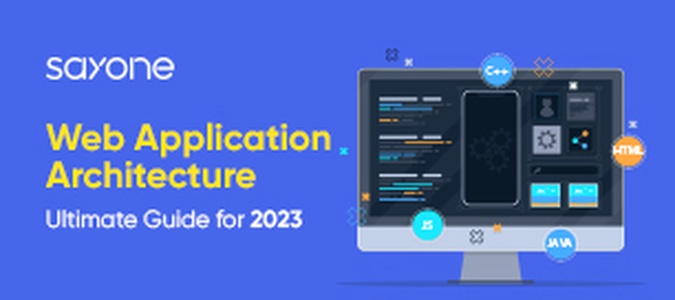Event –Driven Architecture - Fundamental for Digital Transformation

Share This Article
Web Application Architecture Ultimate Guide for 2023
Table of Contents
Subscribe to Our Blog
We're committed to your privacy. SayOne uses the information you provide to us to contact you about our relevant content, products, and services. check out our privacy policy.
The importance of event-driven architecture in the supply chain can never be underestimated. For most businesses and even enterprises, there is no core function that can become such a competitive factor as supply chain management (SCM). For any enterprise or business attempting digital transformation, the IT and business departments first set upon perfecting the SCM of the organization.
Event-driven architecture is the most fundamental aspect that helps to enable the digital transformation of a business.
A well-designed EDA is one that allows businesses and enterprises to react in real-time to production, detection, and consumption of events. This means that any significant change in the state is recognized by the software system in place. Examples of events such as placing an order, selling a product, etc., can be the events.
This is applicable to diverse industries such as retail, which relies on an online store being in continuous communication with a warehouse and the dispatch team, or aviation, where pilots wait to hear real-time weather updates so that they can carry passengers safely. Today, there is a never-ending stream of real-time data emanating as updates from sensors, website clicks, or internal system changes that work as inputs. Most industries rely heavily on real-time data movement.
Download and read our eBook "Choose the best microservices vendor and trim the costs".
This said, it is not easy to set up a suitable architecture, especially if you are just starting to build a system. Therefore, it is important to know how to build an event-driven architecture system that will supply real-time data for your business.
What is Event-Driven Architecture?
This type of architecture functions best with a set of loosely coupled independent services (microservices) that exchange information with one another whenever there is production and consumption of events. Messages are generated and ingested by interested services when such events occur.
Modern innovators such as Netflix use event-driven architecture systems. According to Gartner, it is predicted that over 50% of businesses will be a part of event-driven digital business ecosystems in the near future.

Any event-driven architecture is defined as a design pattern in which the data is defined as a stream of events that occur. The data streams used are in various forms, such as message queues or enterprise service bus (ESB) mechanisms (such as Apache Kafka).
An event-driven architecture consists of four components: an event, an event handler, an event loop, and event flow layers.
Events and what they are
Events signify some changes that have happened to the current state. They cannot be deleted or changed, meaning they are immutable. They always occur in the order or sequence of their creation. Stakeholders or other interested parties can be notified of such events and take appropriate action using suitable business logic when they subscribe to the list of published events.
Read our blog: How hotels are using technology to generate higher revenue
Any event is caused by a significant change in state, such as when a user takes an action. Some examples would be:
- A customer buys a car and the state changes from "For Sale" to "Sold."
- When an amount is deducted from your account after a transaction
- Clicking on the "book cab" button, after which a cab is booked from your account
Any such event may trigger one or more than one option as a response.
Event Handler
This is simply a software routine that handles event occurrences.
Event Loop
An event loop is a flow designed to handle interaction between any event and its handler.
Event Flow Layers
These are made up three logical layers: Event Producer, Event Consumer, and the Event Channel (or Event Bus).
- The Producer is responsible for the detection and generation of events.
- The consumer consumes the events that are produced by the producer.
- The Event Channel is responsible for transferring events from the event generator to the consumer.
An event-driven architecture is designed to leverage a messaging backbone that delivers messages from producers to consumers. This can either be a traditional publish-subscribe message broker (IBM MQ) or even a distributed log (such as Apache Kafka). A publish-subscribe message broker is structured to help multiple consumers subscribe to different message groups.
Read our blog: Why Chatbots will be critical for the future of Business Intelligence
Messages are deleted as soon as the subscribers have received them. However, a log is an unbounded set of events (ordered). Consumers can keep track of their position in the stream by using offsets.
You can choose any event system according to the nature of the use case. Factors such as size, persistence, and frequency of events or the nature of producers can determine the choice.
Event-driven Architecture: Technologies Used
There is no one definite development framework for developing an EDA-based app. Instead, developers integrate a variety of solutions from many different technology providers.
Looking for the best microservices vendor? Give us a call today.
Some of the technologies that can be used for developing an EDA-based app include:
-
Technologies for Event Capturing
Snaplogic, Dell Boomi, Dataflow, MuleSoft, Apache Apex.
-
Routing technologies
ActiveMQ, RabbitMQ, and Apache Kafka.
-
Technologies for Event Processing
Azure Stream Analytics, Apache Storm, Apache Flink, Amazon Kinesis.
Event-driven Architecture: Advantages
- It is easy to add new events and processes.
- Undesirable changes can be quickly rolled back. You can also move to any event that you want to. This is helpful if problems occur.
- An event-driven architecture notifies you of every successful transaction that takes place (transactional guarantee).
- The EDA is easily replaceable and versatile.
- EDA is highly responsive, meaning you do not have to wait for issues to occur; you can detect them in advance and ensure that the app keeps on working.
Points to keep in mind
The event-driven architecture model offers many benefits. However, implementation is not a simple job. The following are some points to keep in mind while implementing the EDA:
Increased Complexity
Being loosely coupled and highly distributed in EDA systems, it’s difficult to find out which event is connected to which microservice and the dependencies between them. Understanding the flow of events is not so easy. Sometimes, a very small change can result in a chain of reactions.
Less Control in EDA
It is not possible to have much control or visibility over events in EDA. There is no clear definition of which events should not be consumed and which should. This loss of control can cause some confusion.
Read our blog "How Technology is Changing Retail Trends in 2022".
Some events cannot be undone
It is easy to roll back changes in EDA; however, there are some that you cannot undo. This is because such an event is dependent on external systems. As an example, there is nothing you can do about an email that you have already sent.
An Event-Driven Business
Customers are moving towards buying products and services as experiences, and they expect companies to provide them with real-time updates for the best outcomes. In such value-driven customer experiences, data is now the new currency that travels through supply chains.
The data movement is often overlooked. A suitable IT infrastructure at the heart of a business can either boost the organization’s bottom line and its customers’ experience by allowing fast and effective movement of data through the system.
With such a movement of data, businesses can make better-quality decisions. Key insights are revealed, and this increases efficiency across the entire business operation.
Conclusion
Before making a technical design implementation in your organization, it is important to rub in cultural awareness about how event-driven architecture will fit into your organization’s digital transformation strategy. It is important to educate employees and stakeholders about EDA and the benefits it will bring about, such as responsiveness, agility, and a better customer experience. Furthermore, it is even more important to keep your workforce motivated on a daily basis by proving those benefits time and again.
How SayOne Can Help
At SayOne, our integrated teams of developers service our clients with microservices that are fully aligned to the future of the business or organization. The microservices we design and implement are formulated around the propositions of Agile and DevOps methodologies. Our system model focuses on individual components that are resilient, fortified, and highly reliable.
We design microservices for our clients in a manner that assures future success in terms of scalability and adaptation to the latest technologies. They are also constructed to accept fresh components easily and smoothly, allowing for effective function upgrades in a cost-effective manner.
Our microservices are constructed with reusable components that offer increased flexibility and offer superior productivity for the organization or business. We work with start-ups, SMBs, and enterprises and help them visualize the entire microservices journey and also allow for the effective coexistence of legacy systems in the organization.
Our microservices are developed for agility, efficient performance and maintenance, enhanced performance, scalability, and security.
Share This Article
Subscribe to Our Blog
We're committed to your privacy. SayOne uses the information you provide to us to contact you about our relevant content, products, and services. check out our privacy policy.

